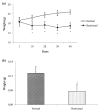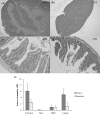Dietary restriction abrogates antibody production induced by a DNA vaccine encoding the mycobacterial 65 kDa heat shock protein
- PMID: 19607696
- PMCID: PMC2717961
- DOI: 10.1186/1479-0556-7-11
Dietary restriction abrogates antibody production induced by a DNA vaccine encoding the mycobacterial 65 kDa heat shock protein
Abstract
Background: Protein-calorie malnutrition (PCM) is the most common type of malnutrition. PCM leads to immunodeficiency and consequent increased susceptibility to infectious agents. In addition, responses to prophylactic vaccines depend on nutritional status. This study aims to evaluate the ability of undernourished mice to mount an immune response to a genetic vaccine (pVAXhsp65) against tuberculosis, containing the gene coding for the heat shock protein 65 from mycobacteria.
Methods: Young adult female BALB/c mice were fed ad libitum or with 80% of the amount of food consumed by a normal diet group. We initially characterized a mice model of dietary restriction by determining body and spleen weights, hematological parameters and histopathological changes in lymphoid organs. The ability of splenic cells to produce IFN-gamma and IL-4 upon in vitro stimulation with LPS or S. aureus and the serum titer of specific IgG1 and IgG2a anti-hsp65 antibodies after intramuscular immunization with pVAXhsp65 was then tested.
Results: Dietary restriction significantly decreased body and spleen weights and also the total lymphocyte count in blood. This restriction also determined a striking atrophy in lymphoid organs as spleen, thymus and lymphoid tissue associated with the small intestine. Specific antibodies were not detected in mice submitted to dietary restriction whereas the well nourished animals produced significant levels of both, IgG1 and IgG2a anti-hsp65.
Conclusion: 20% restriction in food intake deeply compromised humoral immunity induced by a genetic vaccine, alerting, therefore, for the relevance of the nutritional condition in vaccination programs based on these kinds of constructs.
Figures




References
LinkOut - more resources
Full Text Sources
Research Materials

